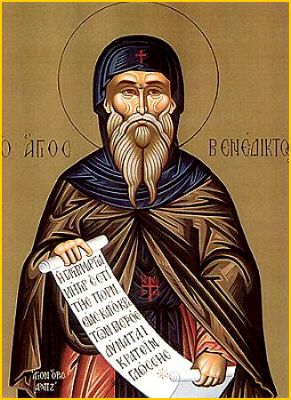|
|||
|---|---|---|---|
| This weekly bulletin insert complements the curriculum published by the Department of Christian Education of the Orthodox Church in America. This and many other Christian Education resources are available at http://dce.oca.org. | |||

The Church remembers Saint Benedict, the founder of monasticism in the Western Church. Benedict and his twin sister Scholastica were born to prominent parents and had many advantages. Though their birthplace was Nursia, a small town near Spoleto, they spent much of their childhood in the city of Rome. Our best source for information about Benedict is the account by Saint Gregory Dialogos, who wrote about many Italian saints and who is also credited with the Liturgy of the Presanctified Gifts. Gregory tells us that Benedict, in his late teens, left his home to seek a place less crowded and boisterous, more serene and natural, than the big city. He knew he was giving up a life many would consider desirable. Gregory writes: "He was in the world and was free to enjoy the advantages the world offers, but drew back his foot which he had...already set forth in the world." After some time, Benedict realized he wanted to do more than avoid the excesses of the city. He wished to become poor and work hard, depending only on God. He found a remote ravine with a deep, craggy cave. There, except for occasional visits from a monk who lived nearby, he spent three years in almost complete solitude. Benedict didn't remain solitary. He had matured and grown spiritually during his time in the cave, and his holy way of life became known. When the abbot of an area monastery died, the brothers begged Benedict to take his place. He hesitated, knowing that their monastic rule was more relaxed than his, but finally acquiesced. It only led to disagreements about his rigorous way of life. One monk was so incensed, or perhaps so jealous, that he attempted to poison the new abbot. Benedict sorrowfully returned to his cave. But other monks had heard of Benedict's increasingly frequent miracles, admired his monastic efforts, and wanted to follow him. He oversaw the building of twelve monasteries, each housing twelve monks, to accommodate these men. The monasteries grew and served the people around them by opening schools and welcoming travelers. The monks' life was communal (no solitary hermits) and they balanced prayer with the physical labor that Benedict considered essential to the Christian life. In about the year 529, Benedict moved from the thriving monasteries in the ravine to Monte Cassino, a much more accessible place. He established new monastic communities, and developed the "Rule" which still governs Benedictine monasteries.
Benedict's gentle, moderate and compassionate character is reflected in his description of what an abbot should do: "Let him hate sin and love the brethren. Even in his correction, let him act with prudence and not go too far, lest while he seeks too eagerly to scrape off the rust, the vessel is smashed. Let him keep his own frailty ever before his eyes, and remember that the bruised reed must not be broken." Benedict died in 543, and was buried with another revered monastic: his beloved sister, Scholastica. |
|||
